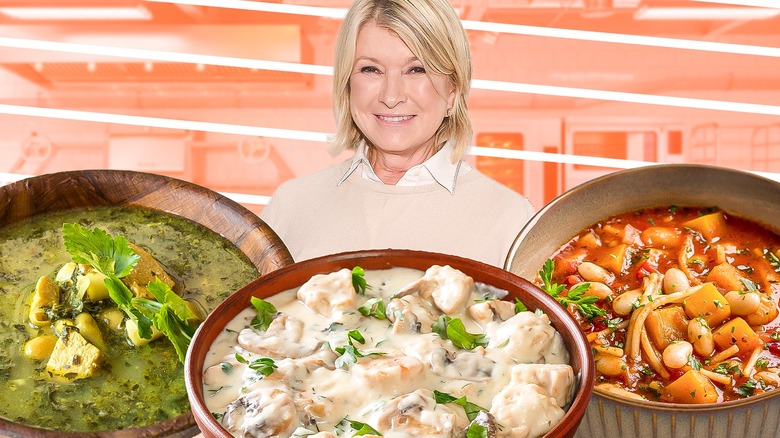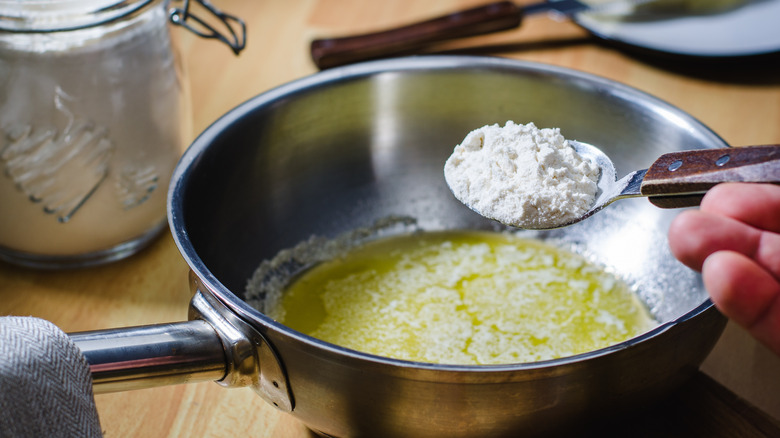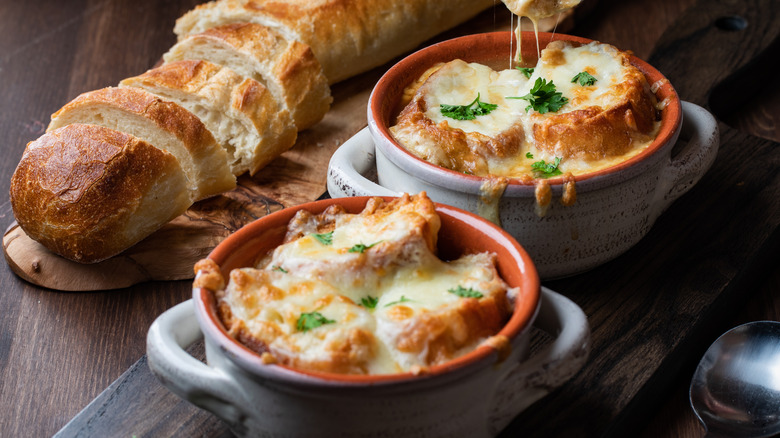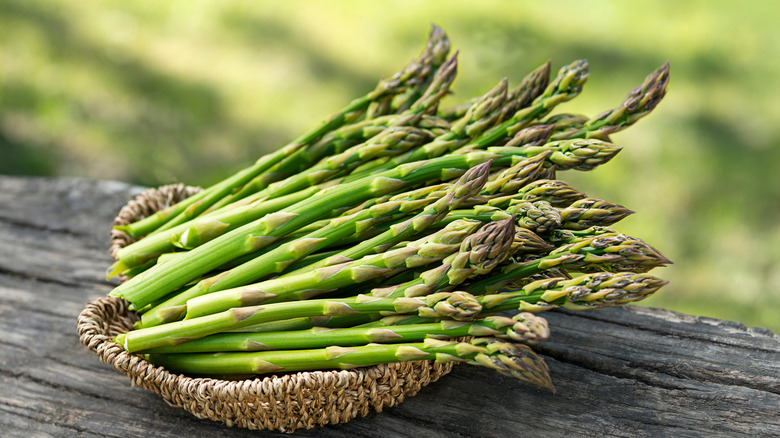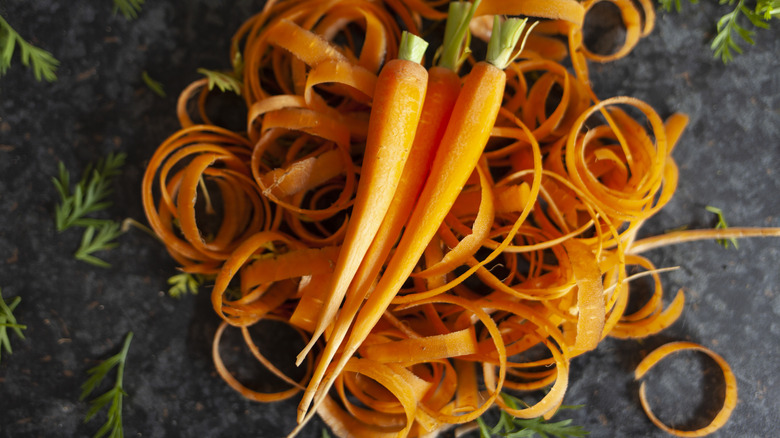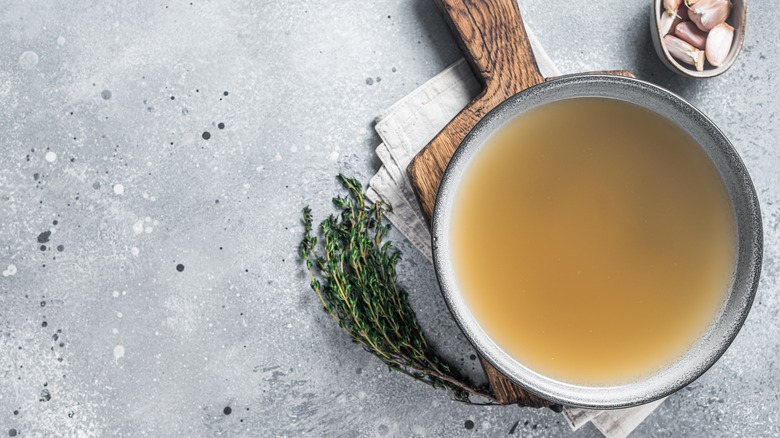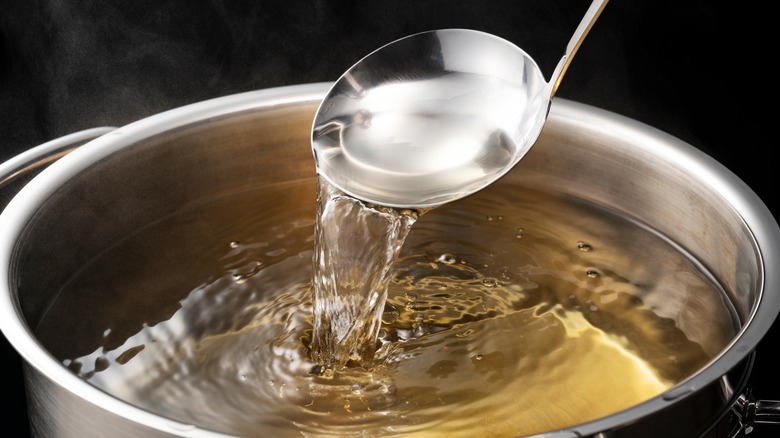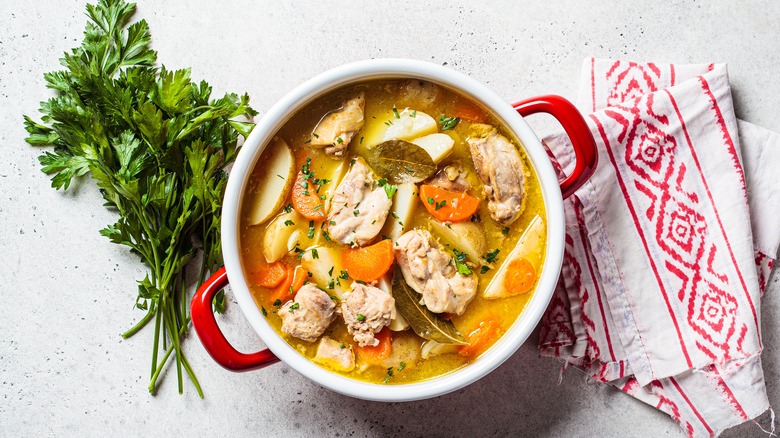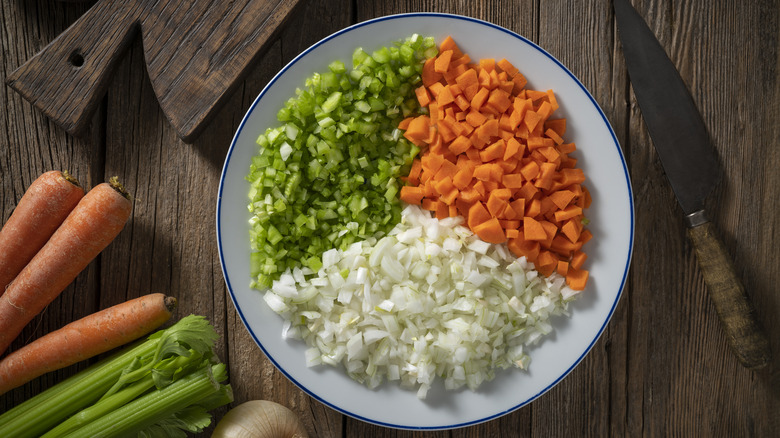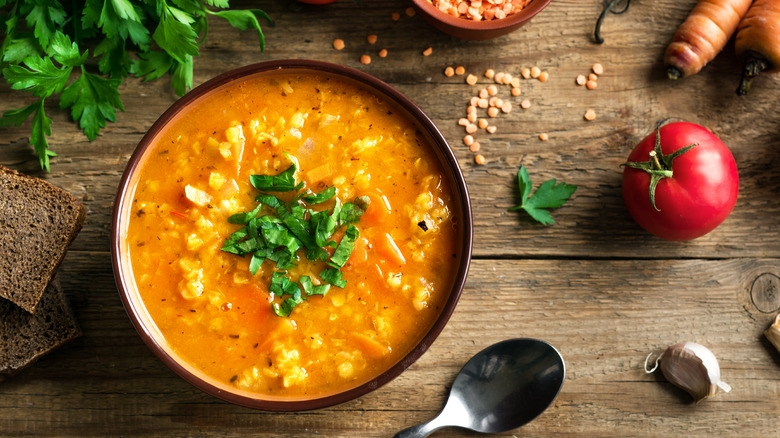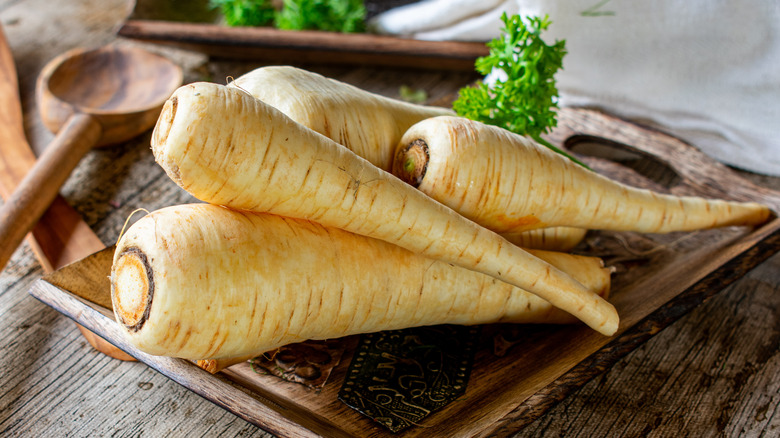Martha Stewart's 11 Tips For Making Soup
Martha Stewart might just be one of the most recognized names in the celebrity chef business. She's been around for decades, through thick and thin, and has opened our eyes to a whole host of methods for cooking, baking, entertaining, and generally running a household. It's no surprise, then, that we should turn to her for making pretty much any type of recipe. Today, the category is soup.
Indeed, when it comes to soup advice, Martha Stewart stands as a beacon of culinary wisdom. From comforting classics to inventive creations, her recipes not only showcase her culinary prowess but also reflect a deep understanding of the nuances that make a bowl of soup truly exceptional. Martha has perfected the art of crafting soups that resonate with both comfort and sophistication. From robust stews to delicate broths, her repertoire encompasses a diverse array of soup recipes, each bearing the distinctive mark of her culinary signature. Whether you are a seasoned chef or a novice in the kitchen, turning to Martha Stewart for soup advice guarantees a journey into the heart of culinary excellence, where each spoonful may fill your belly with gastronomic perfection. So let's take a look at some of her top tips for improving your soup experience this winter.
Incorporate a roux in tomato soup
Tomato soup is an American staple — it's simple, easy to make, requires only basic ingredients, and helps to keep us warm in the winter. But if you were ever looking to upgrade this experience, turning to something a little less simple and perhaps more sophisticated, Martha Stewart can help you make that tomato soup richer without even adding cream.
The trick to her thicker, heartier tomato soup is to prepare a roux before adding the tomatoes. Although this step requires a bit of extra handiwork, it thickens the soup without making it heavy. That's because all you need to make a roux are a couple of tablespoons of butter, compared to the ½ cup of cream that is often required by tomato soup recipes. You can also add your roux at various stages of the soup-making process, depending on your preference: either make the roux in a separate pot and add it to your tomato soup as you would with cream or create your roux with some onions and garlic before adding any of the other ingredients. This last option allows you to incorporate more ingredients and you'll only need a single pot to make it.
Add pesto to minestrone
Minestrone is an ideal winter warmer, even more so than other soups. It's packed with vegetables and plant-based protein, and it can be easily made vegetarian or vegan. There are so many perks to minestrone that it's hard to imagine that it could get any better. Yet with Martha Stewart's tip for adding pesto to minestrone, that's exactly what it does.
Just make sure that you find some very good fresh pesto from the refrigerated section or make the pesto yourself. The jarred stuff isn't going to do much for your taste buds here — those contain so many additives that they end up tasting more like pure salt than anything resembling basil. Luckily, making your own is super easy. Just toss some basil leaves, Parmesan, garlic, salt, and olive oil in a food process and zap away. Once that's done and your minestrone is ready, add a few spoonfuls of your pesto to the soup. For best results, don't stir it in completely. Leave a few swirls here and there, so you can really taste the freshness.
Caramelize the onions in French onion soup
As the name suggests, French onion soup is packed with onions. But it's not enough to just cook them up any old way, or it would be called regular onion soup. Rather, Martha Stewart reminds us that in French onion soup, it's important to caramelize those onions, so they take on additional sweetness and more depth of flavor.
To get this trick right, be sure to give yourself enough time. It takes time to properly caramelize an onion, and Martha Stewart's recipe requires a whole hour — anything less than that might yield a weak flavor. Meanwhile, overcooking the onions would burn them, so this is not the type of thing you can walk away from: You'll have to watch over those onions as they cook, stirring them occasionally and tasting them for doneness. You should also pay attention to the type of onions you use. To aid in the caramelization process, go for a naturally sweet onion, like a yellow one.
Make asparagus soup with leeks and shallots
Just because something is called asparagus soup doesn't mean it can't have any other vegetables in it. It just means the asparagus is the star of the show. But to truly shine, it needs some help, and, in Martha Stewart's asparagus soup, help comes in the form of leeks and shallots, which help provide a welcome sweetness to the dish.
So next time you make asparagus soup, or any type of soup that you think should be a bit sweeter, swap out the onions for these other alliums. Leeks and shallots tend to be milder than onions, providing that signature oniony bite without all the spiciness. Just be sure to saute and soften them in a pot or pan early in the cooking process before you add the rest of the ingredients, which are butter, asparagus, vegetable broth, and seasoning. Softening them will remove any residual bite they might have and make it easier to puree them later in the recipe. Top the soup with crème fraîche before serving.
Save vegetable scraps for homemade broth
If you like to save money, Martha Stewart has a smart hack for making homemade stock practically for free. This tip involves saving vegetable scraps from other recipes, such as carrot peels, and using those to flavor the broth you make for your minestrone or tomato soup.
This may seem unsavory to you at first. After all, carrot peels often get thrown in the trash as they don't seem like they could contribute much in the first place. But if you do as Martha says, you'll have a whole new ingredient to work with. She suggests putting your vegetable scraps in a food processor and pulsing them with some additional fresh aromatics, like garlic, ginger, or bay leaves. Then cook this in water with seasoning and anything else you might want to add, such as a chicken carcass or its bones, and then strain out any solids. You'll be left with a perfectly functional and downright tasty homemade broth for soups and other applications. And if you don't plan on making soup right away after creating vegetable scraps, that's okay. You can freeze those scraps for later, or you can make the broth and freeze that in an ice cube tray.
Rinse out the roasting pan for beef stock
Although you might use chicken or vegetable stock most often in your soup recipes, beef stock also has its place, providing the ideal base for a French onion soup, for instance. And if you don't have the faintest clue about how to make beef stock, Martha Stewart has you covered, if you're willing to put in the work.
To start, you'll need to roast veal and oxtail bones along with some vegetables, aromatics, and tomato paste. Once this is ready, you'll need to remove the meat from the bones, place them into a stockpot with the vegetables, and deglaze the roasting pan with red wine. The result of this process will create a substance known as "fond," which is basically the bits of meat that have come off the bottom of the roasting pan. This fond should then go into the stockpot with everything else, along with plenty of water. And here is where Martha shines: Instead of just using water from the tap, she pours some water into the used roasting pan to pick up any remaining pieces of meat or fat left behind and then uses that water in the stock.
Avoid boiling the stock
In the culinary world, there is a big difference between heating something up and boiling it. As useful as boiling can be in some situations, it can completely destroy a delicate ingredient when used incorrectly. Or it can lead to an unsightly product. One example of the latter phenomenon is the preparation of stock. According to Martha Stewart, one must never boil stock, as this could lead to a cloudy substance.
Although the flavor of your stock might not be affected by this chemical reaction, boiling will almost certainly lead to something with a sludgy appearance, and the last thing we want to be eating when we dine on soup is something ugly and sludgy. Rather, the trick is to simmer. Once you pour your water into your pot to make your broth, monitor it so that it doesn't come to a boil. If you see those bubbles starting to rise and get bigger, lower your heat. It may take longer to finish off your stock, but it will produce the best results.
Prepare chicken soup with a whole chicken
Many homemade chicken stock recipes call for chicken bones — either leftover rotisserie chicken bones from a previous meal, stripped of meat, or chicken bones with some meat left on them. This stock is then used as a base for many soups, including classic chicken soup. But Martha Stewart goes a step further, calling for us to make our chicken soup with a whole chicken — bones, skin, meat, and all the rest included.
If you're thinking you don't have a stockpot that is large enough for this feat, don't worry about that. The chicken needs to be whole only in the sense that every part of it should be included. You can certainly cut it up, and indeed, she recommends cutting it into eight pieces. As for the pot itself, she calls for one that is "just large enough for all the ingredients," as she explains in her YouTube video. The result will be a chicken soup made with a chicken stock on steroids. As Martha explains, "We are using chicken with lots of meat on it. The meat is what gives more flavor. If we were using just assorted bones and backs and necks, you would get your stock, but you wouldn't get the rich, rich flavor of this chicken soup." So make this all-in-one chicken stock and chicken soup recipe, and if you have any liquid leftover for another soup, all the better.
Don't skip the soffritto in your minestrone
A minestrone soup has a lot of moving parts. There's the fragrant broth, the chopped vegetables, the hearty pulses, the starchy pasta, and whatever else you want to add to the mix. Many of these parts can be played around with or switched up, but Martha Stewart advises against skipping the soffritto in a YouTube video.
Soffritto, which is Italian for saute, refers to a blend of sauteed onion, carrots, and celery. It provides the foundation of flavor for any good minestrone. Just pour a ⅓ of a cup of olive oil into a pot and add one finely diced celery, one finely cubed onion, and one finely chopped carrot. Stir until everything is translucent — including the carrots — which should take about 25 minutes. Everything will reduce down to a deep browned color. Then simply add your garlic and the rest of your minestrone ingredients. At this point Martha adds fresh carrots and celery, among other vegetables, noting that even though these elements are already present in the soffritto, they are now about to play a different role in their fresh forms.
Put some thought into your lentil soup
Lentil soup often scores highly on the list of America's favorite comfort foods, especially during the colder months. But there are a lot of considerations that go into making the perfect lentil soup, so we thought we'd turn to Martha Stewart, who we think is a soup genius, among other types of genius, for advice.
On her website, Stewart provides a guide to making the best possible lentil soup from scratch, going into detail about each step. For one, she suggests choosing the right lentils. Although any type is fine for soup, with the added bonus that lentils don't need to be soaked, as dried beans do, it's important to remember that different types come with different cooking times. For a faster-cooking soup, for instance, go for the red kind. Once the lentils are decided, be sure to use a good quality broth. For this, you can use chicken, vegetable, beef, or even lamb stocks, as long as they're packed with flavor. Lastly, there's no need to go overboard on the base. Just saute a bit of onion and garlic in olive oil, with carrots and celery if you wish, and you will be creating a tasty foundation.
Include a parsnip in your chicken soup
Martha Stewart has so many tips for improving your chicken soup it's hard to pick just one. But we think it's important to note that she recommends adding parsnip to the broth that will eventually become your soup. As she explains in her YouTube video on the subject, "parsnips add a subtle sweetness to the chicken soup," which gives it another layer of flavor.
Speaking of vegetables, Martha also has a thing or two to say about the timing of adding them to the pot. First, she adds carrots and other vegetables in large, roughly chopped chunks, but then she also adds fresh ones at the very end. This is because the first "will really not be the vegetables that you will eat," as Martha explains pithily. These are meant to flavor the stock, and in so doing, they will become slightly tasteless. Fresh vegetables, when cooked lightly, will retain much of their original flavor and vigor.
